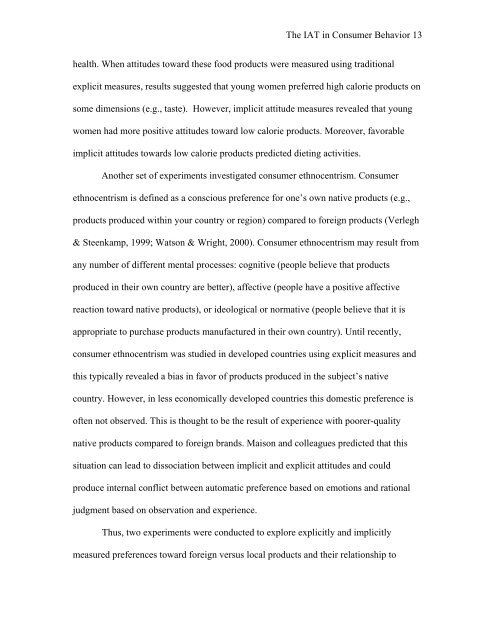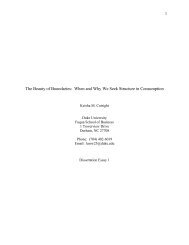RUNNING HEAD: The IAT in Consumer Behavior - Wharton Marketing
RUNNING HEAD: The IAT in Consumer Behavior - Wharton Marketing
RUNNING HEAD: The IAT in Consumer Behavior - Wharton Marketing
You also want an ePaper? Increase the reach of your titles
YUMPU automatically turns print PDFs into web optimized ePapers that Google loves.
<strong>The</strong> <strong>IAT</strong> <strong>in</strong> <strong>Consumer</strong> <strong>Behavior</strong> 13health. When attitudes toward these food products were measured us<strong>in</strong>g traditionalexplicit measures, results suggested that young women preferred high calorie products onsome dimensions (e.g., taste). However, implicit attitude measures revealed that youngwomen had more positive attitudes toward low calorie products. Moreover, favorableimplicit attitudes towards low calorie products predicted diet<strong>in</strong>g activities.Another set of experiments <strong>in</strong>vestigated consumer ethnocentrism. <strong>Consumer</strong>ethnocentrism is def<strong>in</strong>ed as a conscious preference for one’s own native products (e.g.,products produced with<strong>in</strong> your country or region) compared to foreign products (Verlegh& Steenkamp, 1999; Watson & Wright, 2000). <strong>Consumer</strong> ethnocentrism may result fromany number of different mental processes: cognitive (people believe that productsproduced <strong>in</strong> their own country are better), affective (people have a positive affectivereaction toward native products), or ideological or normative (people believe that it isappropriate to purchase products manufactured <strong>in</strong> their own country). Until recently,consumer ethnocentrism was studied <strong>in</strong> developed countries us<strong>in</strong>g explicit measures andthis typically revealed a bias <strong>in</strong> favor of products produced <strong>in</strong> the subject’s nativecountry. However, <strong>in</strong> less economically developed countries this domestic preference isoften not observed. This is thought to be the result of experience with poorer-qualitynative products compared to foreign brands. Maison and colleagues predicted that thissituation can lead to dissociation between implicit and explicit attitudes and couldproduce <strong>in</strong>ternal conflict between automatic preference based on emotions and rationaljudgment based on observation and experience.Thus, two experiments were conducted to explore explicitly and implicitlymeasured preferences toward foreign versus local products and their relationship to




